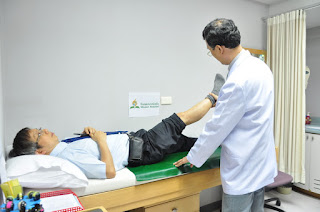Space-Age Robotic Suits Helping Cerebral Palsy Kids Walk
In the regularly advancing universe of innovation meets medication meets cerebral paralysis, comes two exceptionally fascinating stores about youngsters who are figuring out how to stroll with the guide of gadgets that look more like they have a place in a sci-fi motion picture.
The main story originates from WCBS in New York and highlights 13-year old MacKenzie Maher, unfit to stroll since birth because of cerebral paralysis. A major achievement in her journey to walk came cordiality of a cutting edge machine called a Lokomat. MacKenzie partook in a 6-week clinical trial at Shriner's Hospital in Chicago. The Lokomat is a mechanical gadget that "strolls" her body with all the proper developments for a few hours per day. The patient is connected to the bridle and leg ties before a PC controlling the development of her legs on a treadmill. The PC controls the speed and the saddle constrains her legs to copy characteristic movement. The dreary movement re-prepares the muscles to legitimate development and quality without the miscommunications that commonly happen when MacKenzie's cerebrum tries to disclose to her legs what she needs them to do. After time, the treatment retrains the sensory system to sidestep harmed ranges and reestablishes sound neuromuscular capacity.
The expressed advantages of Lokomat treatment are 1) the capacity to keep up a predictable strolling pace, enabling the restorative exercise to be supported for drawn out stretches of time 2) enhancing course, fortifying muscles and enhancing muscle tone 3) reinforcing bones that are generally in danger of osteoporosis from absence of utilization.
The Lokomat, protected by Hocoma, a Swiss organization, got FDA endorsement in 2002 and is in this way secured by some protection programs. At the season of the CBS story, there were 6 Lokomats in the United States.
The second story spins around 18-year old Austin Hammer, a young fellow who experiences spastic diplegia, who has seen significant changes from the utilization of a particular pressure suit that was at first intended for use by the Soviet space program to save and keep up solid muscle tone amid expanded remains in the zero-gravity of room stations. The suit, known as the Euro-Ped Therapy Suit, includes a vest, shorts, knee pieces, shoes and a headpiece, all associated with versatile, bungee-like ropes. The PC controlled strain impersonates the common extension and shortening of solid human muscles and normal development. Like the Lokomat, one to two hour, day by day sessions of redundant, machine-controlled strolling is sufficient to retrain muscles and engine abilities. Proceeded with treatment at the Euro-Peds National Center for Intensive Pediatric Physical Therapy in Pontiac, MI has given Austin the capacity to walk short separations unassisted, something he couldn't already do
The main story originates from WCBS in New York and highlights 13-year old MacKenzie Maher, unfit to stroll since birth because of cerebral paralysis. A major achievement in her journey to walk came cordiality of a cutting edge machine called a Lokomat. MacKenzie partook in a 6-week clinical trial at Shriner's Hospital in Chicago. The Lokomat is a mechanical gadget that "strolls" her body with all the proper developments for a few hours per day. The patient is connected to the bridle and leg ties before a PC controlling the development of her legs on a treadmill. The PC controls the speed and the saddle constrains her legs to copy characteristic movement. The dreary movement re-prepares the muscles to legitimate development and quality without the miscommunications that commonly happen when MacKenzie's cerebrum tries to disclose to her legs what she needs them to do. After time, the treatment retrains the sensory system to sidestep harmed ranges and reestablishes sound neuromuscular capacity.
The expressed advantages of Lokomat treatment are 1) the capacity to keep up a predictable strolling pace, enabling the restorative exercise to be supported for drawn out stretches of time 2) enhancing course, fortifying muscles and enhancing muscle tone 3) reinforcing bones that are generally in danger of osteoporosis from absence of utilization.
The Lokomat, protected by Hocoma, a Swiss organization, got FDA endorsement in 2002 and is in this way secured by some protection programs. At the season of the CBS story, there were 6 Lokomats in the United States.
The second story spins around 18-year old Austin Hammer, a young fellow who experiences spastic diplegia, who has seen significant changes from the utilization of a particular pressure suit that was at first intended for use by the Soviet space program to save and keep up solid muscle tone amid expanded remains in the zero-gravity of room stations. The suit, known as the Euro-Ped Therapy Suit, includes a vest, shorts, knee pieces, shoes and a headpiece, all associated with versatile, bungee-like ropes. The PC controlled strain impersonates the common extension and shortening of solid human muscles and normal development. Like the Lokomat, one to two hour, day by day sessions of redundant, machine-controlled strolling is sufficient to retrain muscles and engine abilities. Proceeded with treatment at the Euro-Peds National Center for Intensive Pediatric Physical Therapy in Pontiac, MI has given Austin the capacity to walk short separations unassisted, something he couldn't already do




No comments